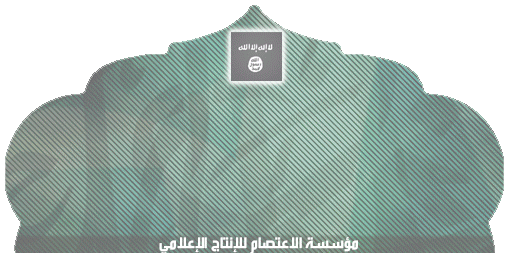NOTE: An archive of the Musings of an Iraqi Brasenostril on Jihad column can now be found here.
–
By Aymenn Jawad Al-Tamimi
Introduction
On account of the border with Iraq, one might infer through common sense stronger links in Deir ez-Zor and the east with mujahideen in Iraq fighting under the command of Sheikh Abu Bakr al-Baghdadi, who announced the Islamic State of Iraq and ash-Sham (ISIS) in the first place. Thus, it might be predicted that ISIS has either taken over the eastern areas completely or is otherwise indistinguishable from Jabhat al-Nusra (JAN), as is the case in Raqqah.
The city of Deir ez-Zor
An overview of the evidence demonstrates a more complicated picture. In the city of Deir ez-Zor itself, it would appear that JAN and ISIS are two separate entities. This can be shown by the fact that there is no overlap in claimed operations for the two groups.
Thus, the main source for ISIS actions in Deir ez-Zor comes from the pro-ISIS channel ash-Sham, which put out a video of members of ISIS destroying a Shi’i mosque in Deir ez-Zor. Confirmation of ISIS responsibility is made clear by the fact that the opening speaker introduces those in the video destroying the mosque as members of ISIS.
Here is another video released by ash-Sham of ISIS gunmen executing two men in Deir ez-Zor, described in the video tag as ‘murtadeen’ (‘apostates’) and apparently guilty of crimes against Muslims. ISIS also appears to be playing a role in the ongoing battle for Deir ez-Zor airport between regime forces and rebels. Considering that those under the banner of the ‘Free Army/FSA’ are continuing to fight for the airport, it is likely that there is coordination in this operation between ISIS and other rebels.
JAN is also playing its own role in leading and coordinating operations with other rebels, despite what appeared to be a decline in evidence of JAN activity in Deir ez-Zor (contrasting with the western regions of the country) between Sheikh Baghdadi’s announcement of ISIS and Sheikh Aymenn al-Zawahiri’s letter of compromise between ISIS and JAN.
Thus, on 15 June, some rebel outlets reported that JAN along with the ‘Jamaat al-Tawhid wa l-Jihad’ had taken over the military court in Deir ez-Zor. Ugarit News says that the operation was a joint one between JAN and those under the banner of the ‘Free Army’, with additional mention of a joint JAN-‘Free Army’ takeover of a Bemo Bank building. Neither of these operations has been claimed for ISIS, and vice-versa as regards ISIS actions in Deir ez-Zor.[i]
Abu Kamal and the Kata’ib Junud al-Haq
Outside of Deir ez-Zor- in particular in eastern towns freed from regime control- there is not really a clear distinction between ISIS and JAN. The best case-in-point comes from the town of Abu Kamal on the Euphrates that is right on the border with Iraq, making links with jihadis in Iraq perfectly logical. During the upsurge in claimed ISIS videos in mid-May, one emerged purporting to show ISIS’ presence in Abu Kamal, allegedly showing operations by the ‘Kata’ib Junud al-Haq’ (‘Battalions of the Soldiers of Righteousness’- KJAH) based in Abu Kamal and with claimed affiliation to ISIS.
Later that month, another video emerged of an ISIS training camp for youths in Abu Kamal. For instance, at 0:33 in the latter video, some of the ISIS cub scouts are seen holding the ISIS banner with the inscription ‘Islamic State of Iraq and Sham’ in Arabic and English.
The clip also includes teaching children to disarm opponents of their weapons at close quarters, marksmanship and using sniper rifles. Moreover, there is the chanting of slogans such as ‘God preserve the Muhajireen’ (3:52), suggesting that some foreign fighters- and in this case I would in particular suggest Iraqis from the Islamic State of Iraq (ISI)- have been involved in the running of the training camp.
The key to tracking developments as regards the ISIS-JAN relationship in Abu Kamal lies in KJAH, about which nothing in English has otherwise been written. A look at the group’s Facebook page is most revealing. Originally, KJAH was set up as a front-group for JAN in Abu Kamal. This is apparent from their first logo that included the name of Jabhat al-Nusra underneath ‘Kata’ib Junud al-Haq.’
Furthermore, in March, a video was released purportedly showing dead Shabiha fighters in the town of ash-Shaddadi in Hasakah province. The speaker in the video mentions that the men were killed at the hands of ‘Kata’ib Junud al-Haq- Kata’ib Jabhat al-Nusra.’
Here is another video of the battalion coordinating operations with those identifying as the ‘Free Army’ in trying to take Kabajab from regime forces (in Deir ez-Zor province). Note that neither of these videos was released through al-Manārah al-Bayḍā, suggesting that like the JAN military council in Deraa, KJAH should in theory enjoy some degree of autonomy.
At the same time, KJAH’s sympathy- at the minimum- with Sheikh Baghdadi’s ISI was made clear with another emblem uploaded in March to mark a purported JAN offensive to take Homs. The name of Jabhat al-Nusra is inscribed as with the first logo but part of the ISI logo is incorporated, perhaps acknowledging KJAH’s debt to ISI (something that applies to JAN more generally).
A more glaring change came at the end of April- some three weeks after the announcement of ISIS- that saw KJAH drop JAN’s name from their logo entirely, making clear its affiliation to ISIS. Indeed, the impression of ISIS affiliation was strengthened by those two videos in May mentioned above.
The battalion also released a statement in mid-May- under its own name but openly claiming membership of ISIS- addressed to the people of Abu Kamal, notifying them that the battalion’s request for permission for students in Abu Kamal to sit their exams in Abu Kamal rather than in Deir ez-Zor had been turned down.
At the same time, the switch to ISIS name and imagery did not mean a rejection of or hostility towards JAN, as indicated by the fact the Facebook page uploaded a photo featuring JAN fighters and their logo on 10 May.
In any event, when Sheikh Zawahiri announced his compromise ruling in favor of maintaining JAN’s name, KJAH switched back to claiming affiliation with JAN, while maintaining on its Facebook page the logo adopted after Sheikh Baghdadi’s announcement of ISIS.
The most recent statement released by KJAH explicitly states affiliation as JAN’s wing in Abu Kamal, discussing a recent problem of residents of villages near Abu Kamal receiving weapons from regime forces in Deir ez-Zor.
KJAH is a good example of how defining the exact ISIS-JAN relationship in Syria can be difficult to describe in general terms. Certainly the changes in claimed logos and affiliations reflect the disputes at the leadership level of the jihad in Syria over the names of JAN and ISIS, but KJAH’s adoption of one or the other did not mean hostility to the other name or banner, regardless of the battalion’s composition.
Further, besides the praise of ‘Muhajireen’ being taught in the then KJAH/ISIS camp in Abu Kamal, one should note that some of KJAH Facebook postings appear to have been made in Baghdad, adding credence to my hypothesis of strong links between the mujahideen in Abu Kamal and Iraqi fighters, if not the presence of Iraqi mujahideen in Abu Kamal.
If that be the case, then Abu Kamal presents an example of how views on JAN and ISIS are not always predictable according to a foreign-fighter vs. native Syrian dichotomy.
Category: Iraq
Hizballah Cavalcade: Breaking Badr: Is Iraq’s Badr Organization Operating In Syria?
NOTE: For prior parts in the Hizballah Cavalcade series you can view an archive of it all here.
—
Breaking Badr: Is Iraq’s Badr Organization Operating In Syria?
By Phillip Smyth ([email protected])
Click here for a PDF version of this post
Due to many public funerals, a number of Iranian-backed Iraqi organizations (Asa’ib Ahl al-Haq, Kata’ib Hizballah, and Kata’ib Sayyid al-Shuhada stand as prime examples) have been identified as supplying combatants to fight in support of the regime of Bashar al-Assad in Syria. However, the Badr Organization, an Iraqi group which has pledged its loyalty to Tehran, was absent from announcements involving Iraqis killed in Syria and has been rather murky on whether it is fighting in Syria.
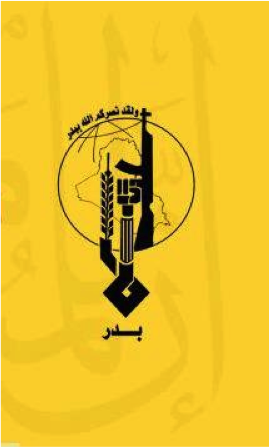
Figure 1: The Badr Organization Military Wing’s logo. Note its similarity to Lebanese Hizballah’s, Asa’ib Ahl al-Haq’s, Kata’ib Hizballah’s and the Iranian Revolutionary Guard Corps’ logos
In February, 2013, Hadi al-Amiri, leader of Iraq’s Badr Organization, said Turkey and Qatar were supplying Al Qa’ida and that this was a declaration of war against Iraq.[1] During a June 21, 2013 interview with Reuters, Amiri said the group was contemplating intervening in Syria and could not, “sit idle while the Shi’ites are being attacked”. [2] Regardless, after assessing posted material issued by the Badr Organization’s social media webpages, it is becoming clear the group may actually be involved in the fighting in Syria.
Beginning life as the Badr Brigade, the militia for the Supreme Council for the Islamic Revolution in Iraq (SCIRI), the Badr Organization split from SCIRI and became its own political group.[3] In 2006, the Council on Foreign Relations reported the Badr Organization had upwards of 10,000 militiamen.[4]
Before and after the split with SCIRI, the Badr Organization received heavy funding, training, and equipment from Iran.[5] The group is also unabashed about its close links with Iran, especially Iranian Supreme Leader Ayatollah Ali Khamenei, and Iranian proxy groups.
Despite material which affirms the group supports the actions of Lebanese Hizballah in Syria, the official Facebook page for the Badr Organization makes no mention that its militiamen may be also operating in Syria. Nevertheless, there are hints of involvement on the group’s page for the Badr Organization Military Wing, the Badr Organization’s militia. Throughout the Spring of 2013, the Badr Organization increased the level of supportive rhetoric for Lebanese Hizballah, Asa’ib Ahl al-Haq, Kata’ib Hizballah, and Iran’s efforts in Syria. A June 21, 2013 photo’s caption said the, “Badr Military Wing will defend Zaynab to the last mujahid”.
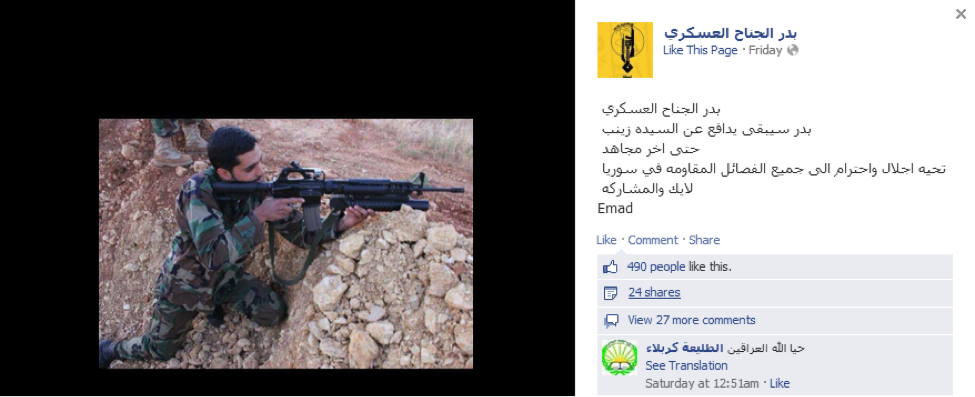
Figure 2: Photo from the Badr Organization Military Wing’s Facebook saying the group will “Defend the Zaynab Shrine to the last holy warrior [mujahid]”.
Earlier, on April 22, 2013, The Badr Organization Military Wing produced and uploaded a song to YouTube. The song’s discription said it was, “A message from Badr to the unjust”and included the lyrics, “We will issue a death sentence against the Free Syrian Army (Jaysh al-Hurr) and no one will be able to defeat us.” The only images present during the music were those of a fighter armed with an RPG-7 in front of the Saydah Zaynab Shrine, the logo for the Badr Organization Military Wing, and the logo for the Badr Organization.
From May 5-9, 2013, a few photographs depicting Badr Organization fighters showing their “Soliderity” with members of Liwa’a Abu Fadl al-Abbas (LAFA) appeared on various pro-LAFA, Badr Organization, and pro-Lebanese Hizballah websites. LAFA has acted as the main front for pro-Iranian fighters inside Syria.
Nevertheless, Badr’s symbols are not a pervasive presence on LAFA or Liwa’a Zulfiqar’s social media websites. Since the group reportedly did not suffer any killed in Syria before June, coverage of the organization’s possible involvement with LAFA or Liwa’a Zulfiqar was muted. The group’s social media posts appeared to do little more than offer visible support for the actions of other pro-Iranian Iraqi groups operating in Syria.
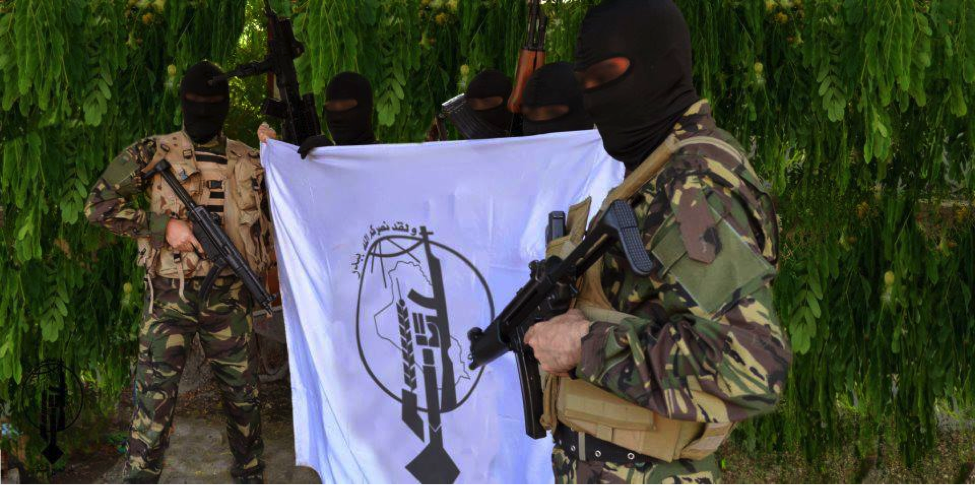
Figure 3: The photo was first posted on the Badr Organization Military Wing’s official and mirror Facebook pages. The photo shows Badr militiamen armed with Heckler and Koch MP5 submachine guns (though, it’s possible these are Iranian copies) and AK-47 style rifles.
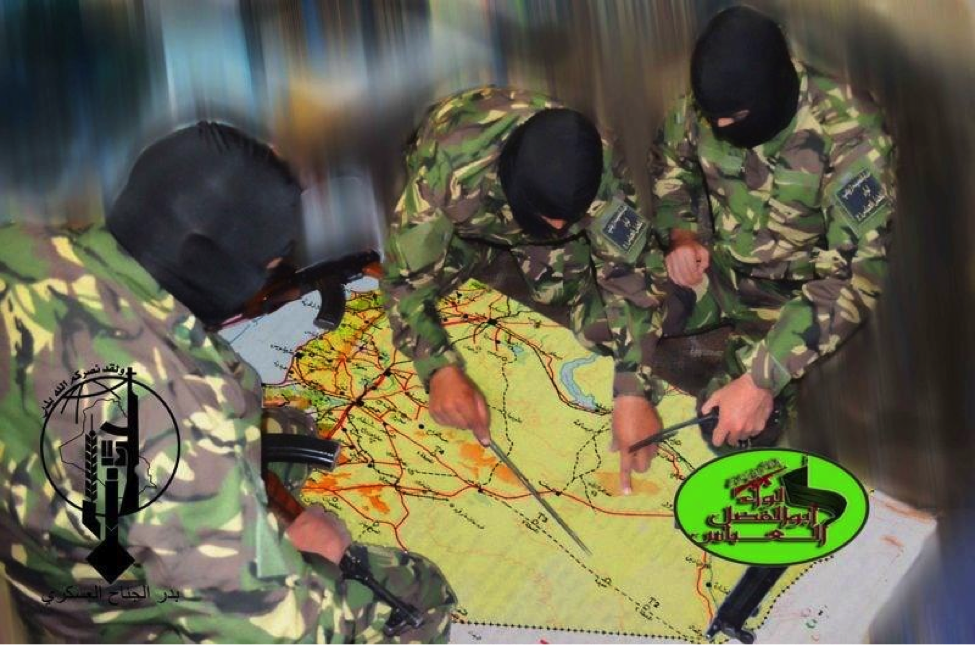
Figure 4: A photo first posted on Liwa’a Abu Fadl al-Abbas’s Facebook page claims to show Badr Organization militiamen studying a map of Syria. Most captions to go along with this photo claimed it was a photo to express solidarity with the defenders of the Zaynab Shrine.
However, the Badr Organization’s public statements regarding Syria grew louder after May 20, 2013. Immediately following attacks on buses carrying Iranian pilgrims near the Iraqi city of Tikrit, the Badr Organization Military Wing announced they would adopt a more threatening posture. [6] The statement said the “Plotters” of the attacks were the United States, Saudi Arabia, Qatar, and “The Zionist Entity” (Israel), and that they would face a swift retaliation. It is important to note that the same compendium of enemies is blamed by Iran and its proxies operating in Syria for being behind forces opposing the regime of Bashar al-Assad. Interestingly, notwithstanding the other, often more horrific bombings Iraqi Shia suffered, and other attacks launched by Sunni Islamists against Shia in Iraq, the Badr Organization appeared to draw a redline with the attack on the Iranians. It is also possible the targeted bus was not carrying Iranian pilgrims as reported, but Iranian advisors or fighters, which would further inflame a pro-Iranian proxy group like Badr.[7]
Based on the fact that other smaller Iranian-backed Iraqi Shia groups have sent fighters into Syria, it is possible the Badr Organization has also sent members. This possibility gained added credence on June 17, 2013 when the Badr Organization Military Wing announced a member had been killed “Defending the Saydah Zaynab Shrine”. Despite this announcement, it is still unclear whether the Badr Organization has committed sizable amounts of fighting men to the war in Syria.
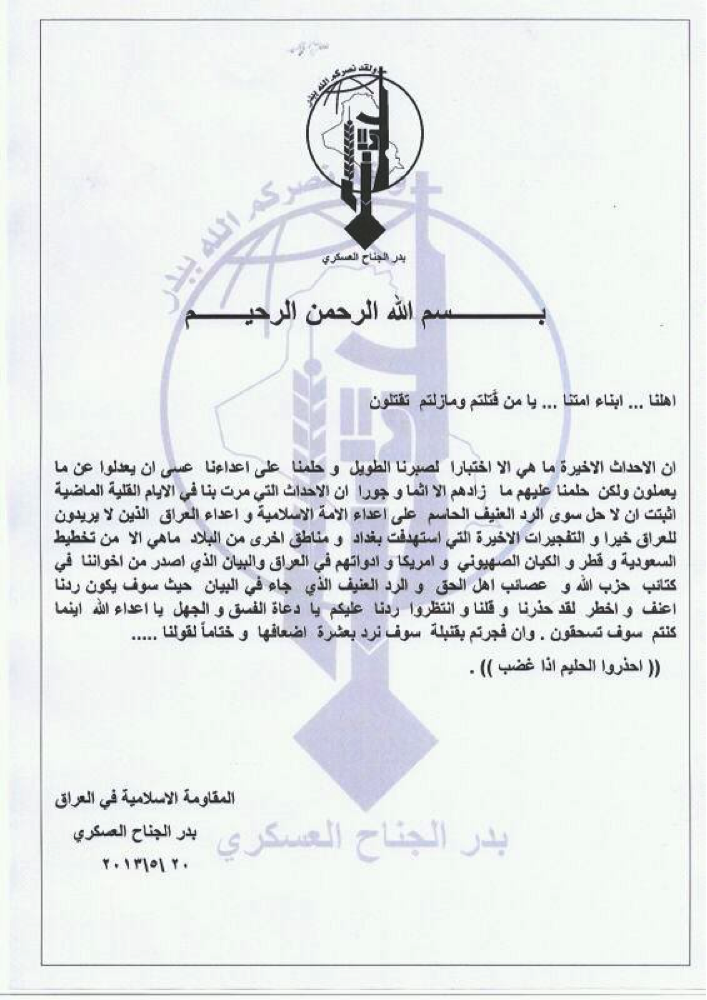
Figure 5: May 20, 2013 Badr statement threatening Saudi Arabia, Qatar, “The Zionist entity”, and the U.S.
The Badr Organization’s First Martyr In Syria?
Name: Yasin Muhammed al-Zayn (A.K.A. Hadi)
Death Announced: June 17, 2013. (He was declared killed on June 17, 2013). The Badr Organization Military Wing’s Facebook declared his death on June 18, 2013.
Notes: Only on the Badr Organization Military Wing’s official page was al-Zayn claimed as a member of the Badr Organization. On his martyrdom poster, it was claimed al-Zayn was killed in the Zayn al-‘Abideen neighborhood of Damascus while “Defending the Saydah Zaynab Shrine”. Other pro-Assad/pro-Iranian backed Shia organization Facebook pages did not mention his affiliation with the Badr Organization. Additionally, no footage of al-Zayn’s funeral could be located. A personal martyrdom page was also created (on June 18, 2013) for al-Zayn.[8] On the page, no mention of any Badr affiliations was made. Interestingly, his death was not claimed by Liwa’a Abu Fadl al-Abbas or Liwa’a Zulfiqar, the two groups Iraqi Shia have fought for in Syria.
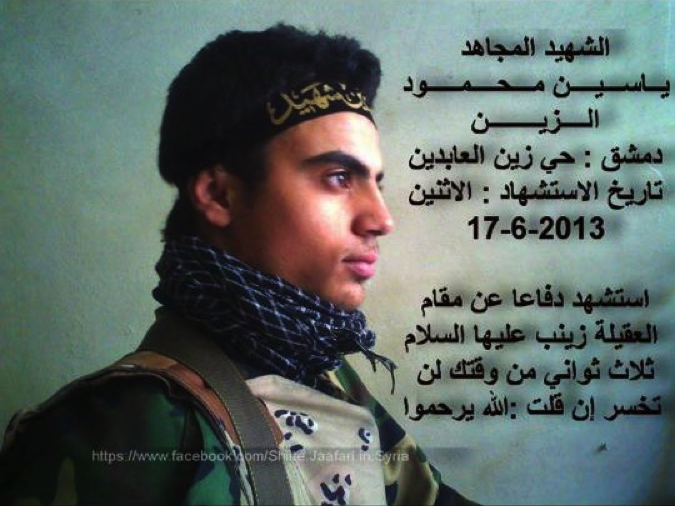
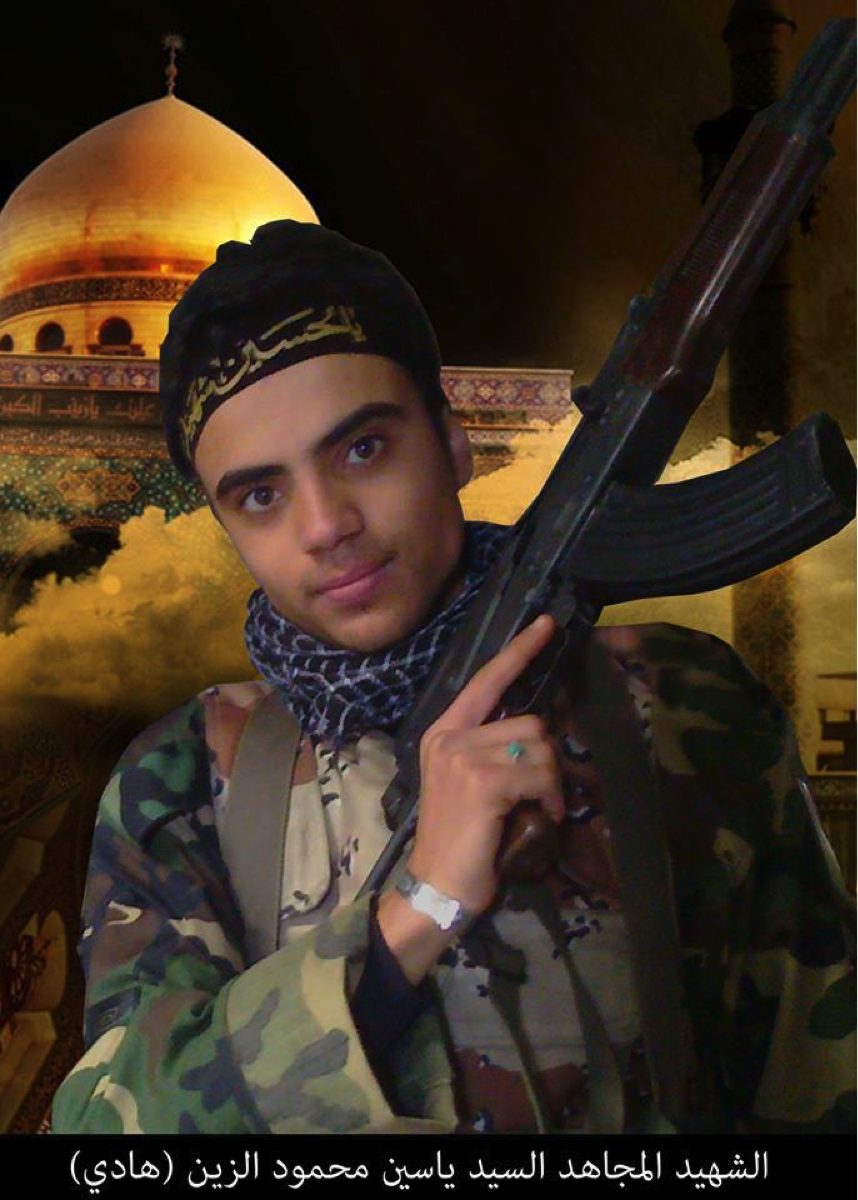
Figure 6: The Saydah Zanab Shrine’s golden dome features prominently in the background. No logos for the Badr Organization Military Wing were present on the martyrdom poster.
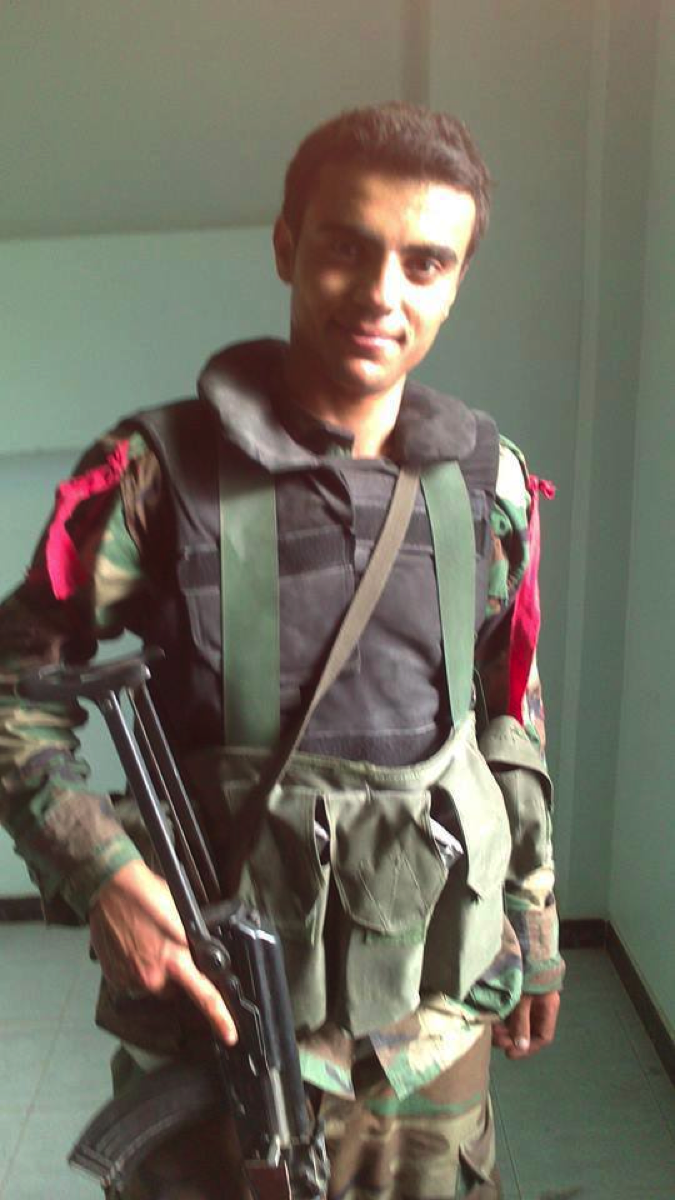
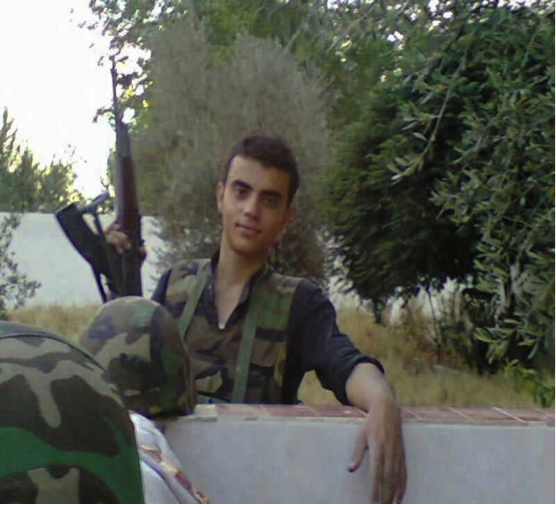
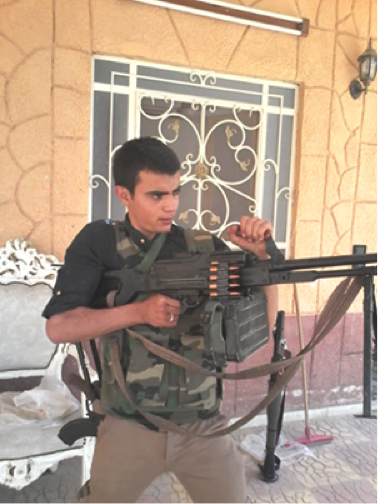
The Badr Organization’s Imagry For Syria
The Badr Organization Military Wing has created a number of provocative online photos dealing with events in Syria. When compared to other Iranian proxies, they have exhibited the most blatant links to Iran’s Supreme Leader. It is possible the group may be setting-up a religious pretext for their [future] involvement in Syria by continually showing pictures of Khamenei. Khamenei had already given religious sanction for Shia fighters to engage in battle in Syria.[9]
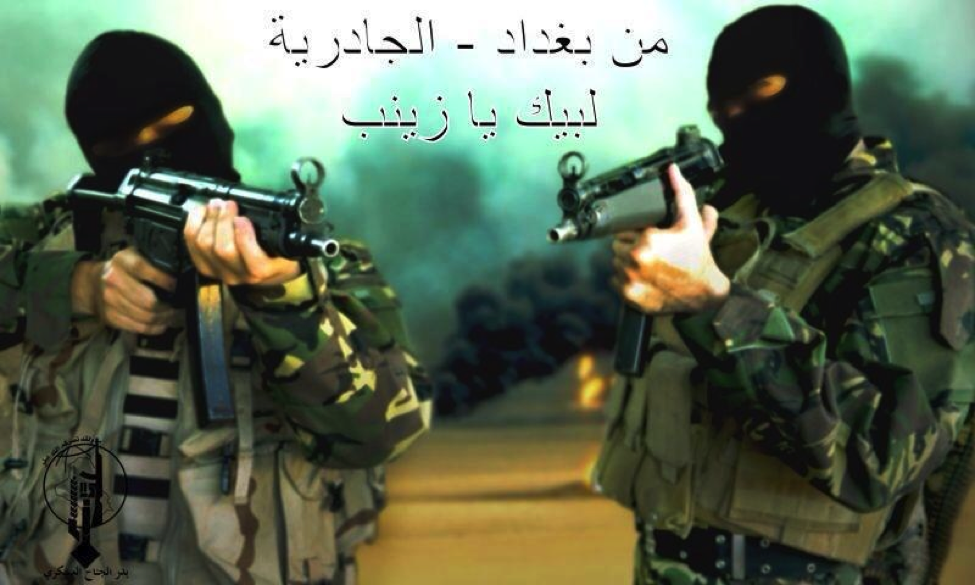
Figure 7: “Min Baghdad – al-Jadriat Labayk ya Zaynab” (“From Baghdad – al-Jadriya [a Baghdad neighborhood] We are here for you, O Zaynab”).
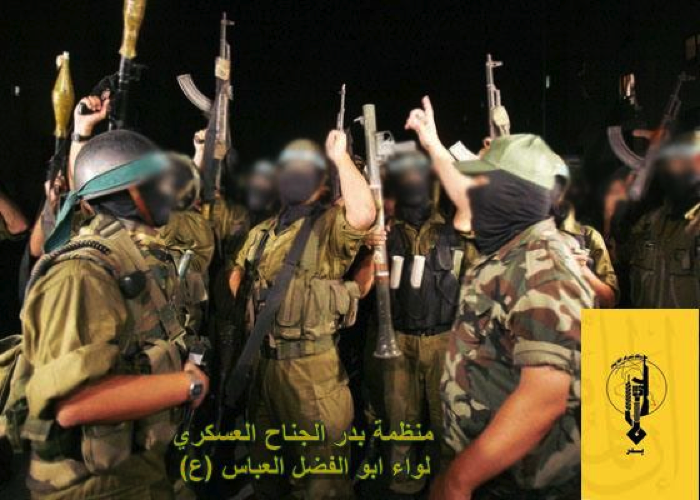
Figure 8: A photo published by the Badr Organization Military Wing showing members of Liwa’a Abu Fadl al-Abbas. The image is attempting to convey that the Badr Organization has members within LAFA.
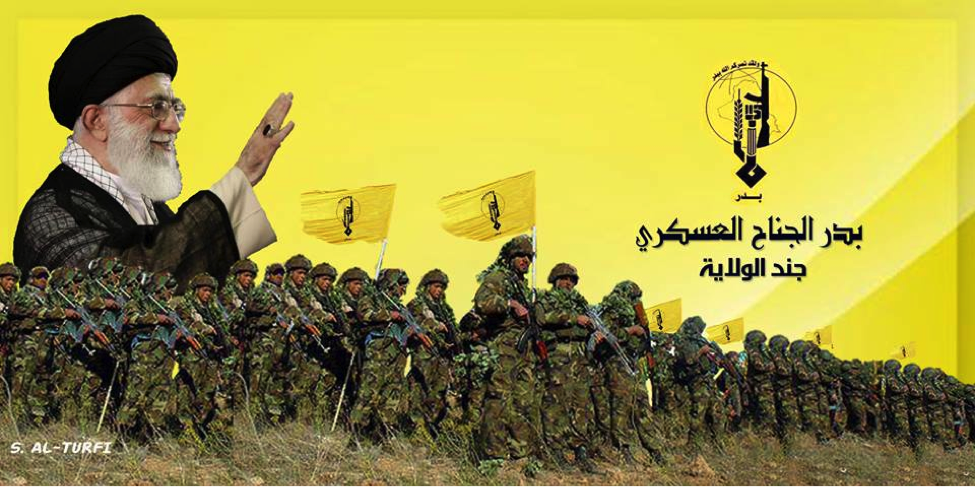
Figure 9: Iran’s Supreme Leader waves and smiles as Badr Organization militiamen stand below him.
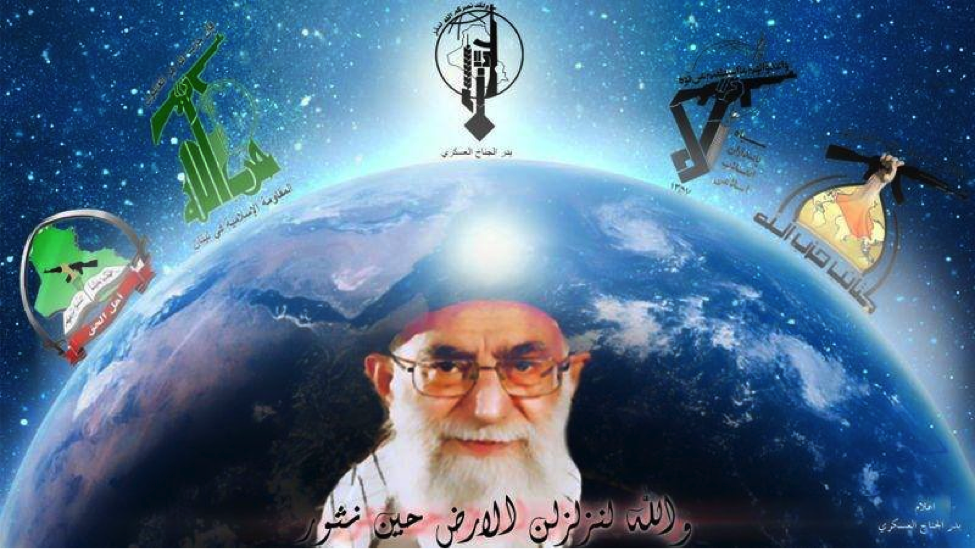
Figure 10: This photo appeared on two pro-Badr Organization Military Wing pages on Facebook. Intriguingly, the photo is extremely blatant about the connection (logos from left to right) Asaib Ahl al-Haq, Lebanese Hizballah, the Badr Organization, the Iranian Revolutionary Guard Corps, and Kata’ib Hizballah share. Iranian Supreme Leader Ayatollah Khamenei looks out from the globe.

Figure 11: Another online poster featuring the Badr Organization Military Wing and Iranian Supreme Leader Ayatollah Khamenei. The background is a photo of Lebanese Hizballah marching with an added golden hue. [1] Michael Knights, “Syrian and Iraqi Conflicts Show Signs of Merging”, March 7, 2013, Policywatch 2042, Washington Institute For Near East Policy, https://www.washingtoninstitute.org/policy-analysis/view/syrian-and-iraqi-conflicts-show-signs-of-merging. [2] See: https://www.trust.org/item/20130621144421-omxch. [3] See: https://en.aswataliraq.info/(S(clhorg45ylfsgrrhg3vbwlmb))/Default1.aspx?page=article_page&id=147369&l=1. [4] See: https://www.cfr.org/iraq/iraqs-militia-groups/p11824#p6. [5] See: https://www.mcclatchydc.com/2005/12/12/v-print/13157/iran-gaining-influence-power-in.html. [6] See: https://now.mmedia.me/lb/en/mena/8-dead-in-iraq-bomb-attack-on-iran-pilgrims-officials-say. [7] Personal conversation with Michael Knights, June 24, 2013. [8] See: https://www.facebook.com/KlnaAlshhydAlmjahdYasynMhmwdAlzyn. [9] See:
New audio-visual message from the Islamic State of Iraq and al-Shām’s Shaykh Abū Muḥammad al ‘Adnānī al-Shāmī: "Ignore Them and Their False Allegations"

_________
To inquire about a translation for this audio-visual message for a fee email: [email protected]
Hizballah Cavalcade: Liwa’a Zulfiqar: Birth of A New Shia Militia in Syria?
NOTE: For prior parts in the Hizballah Cavalcade series you can view an archive of it all here.
—
Liwa’a Zulfiqar: Birth of A New Shia Militia in Syria?
By Phillip Smyth ([email protected])
Click here for a PDF version of this post
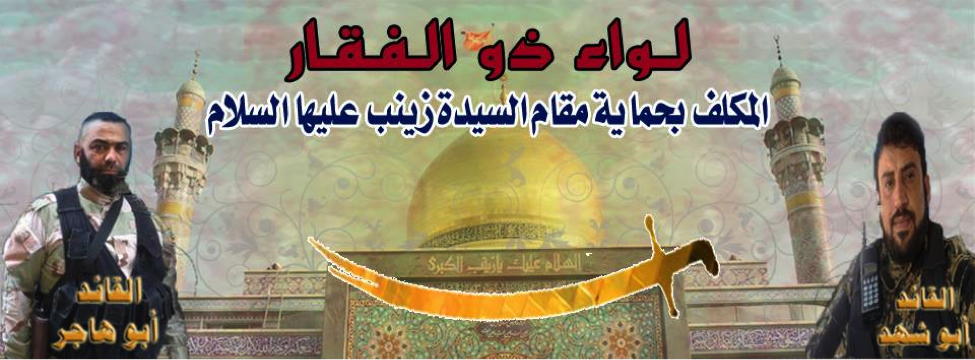
On June 5, 2013, the same day Lebanese Hizballah declared victory at the Battle of Qusayr, a page for a new Damascus-based Shia militia group, Liwa’a Zulfiqar (LZ or the Zulfiqar Battalion), was created on Facebook. The group asserts it is, “Assigned to protect religious shines, especially the Saydah Zaynab [shrine]”. This claim is also held by Syria’s other main Shia militia, Liwa’a Abu Fadl al-Abbas (LAFA). However, Liwa’a Zulfiqar is not competing with Liwa’a Abu Fadl al-Abbas. In fact, most of its members and leadership appear to have been drawn from LAFA. Furthermore, Liwa’a Zulfiqar does not hide the fact that it was created out of Liwa’a Abu Fadl al-Abbas. Along with new photographs, the new group has repackaged older LAFA photographs and claimed them as representations of the new group.
LZ’s formation results in a number of questions: Is Liwa’a Zulfiqar a genuinely new organization? Could it be another front for LAFA? Was LZ’s formation representative of something else going on within the ranks of Shia fighters in Syria?
Based purely on social media data, it appears LZ is less of a new organization, and probably a LAFA front or part of LAFA. At best, the group could be a repackaging of LAFA fighters into a new group which serves the same functions and cooperates closely with LAFA and the Syrian army. At the same time, the group could be little more than a web-based propaganda vehicle. Since the creation of a new organization would generate the sense that larger numbers of capable Shia fighters are flooding into Syria, LZ’s propaganda function may also be aimed directly at rebel morale.
Using unnamed sources, Al-Hayat newspaper reported the majority of LZ’s fighters have come from Muqtada al-Sadr’s Liwa’a al-Yum al-Mawud (Promised Day Brigades), Asa’ib Ahl al-Haq, and Kata’ib Hizballah.[1] The latter two groups have suffered casualties in Syria and have also been integral pieces of LAFA. If LZ is an actual organized entity, it has already established itself as primarily Iraqi Shia staffed. It is unknown whether the Iraqi make-up of the group is a deliberate measure to create a separate purely Iraqi staffed organization. However, based on LAFA’s history of having a membership of mixed nationalities, it is unlikely the group has been formed to suit such a purpose.
Still, new evidence about LZ’s origins may have come to light via a June 19th Reuters report.[2] Liwa’a Zulfiqar may instead be the outgrowth of infighting pitting Liwa’a Abu Fadl al-Abbas’s Syrian commanders, Assad militias, and trained Iraqi fighters who comprise a large chunk of LAFA’s membership. Citing claims by Iraq-based Shia militants, Reuters reported, “Two Iraqi fighters and three Syrian Shabiha died” in a short battle pitting local Assad’s forces against Iraqi Shia fighters. As a result, “divisions fester and Iraqi combatants have formed a new brigade, refusing to fight under Syrian command”. It is possible Liwa’a Zulfiqar is the “new brigade” mentioned in the report.
If Liwa’a Zulfiqar was established due to the infighting, it is highly probable that the old LAFA command and military apparatus has been replicated and simply given a new name. This would explain the repackaging of LAFA photographs and the claims that LAFA leadership now comprises LZ’s leadership.
Nevertheless, it is important to remember that LAFA and LZ would still be reliant on the cooperation of Assad’s forces. Heavy weapons provided to them by the Syrian army, including tank and artillery support, will still be necessary for LZ to mount any offensive or effective defensive operations. Furthermore, supplies for the group need to be funneled through the Assad regime, so a working relationship with Assad’s forces would be necessary.
Importantly, LAFA does not appear to have an interest in heightening any split. LAFA’s official Facebook page even announced the creation of LZ and posted some of their photographs. Also, LZ does not hide their support for the Assad regime. If a split resulting in the creation of LZ really did arise, it appears it was mitigated to the extent that the discord did not spill into public spheres, namely social media.
Liwa’a Abu Fadl al-Abbas & Liwa’a Zulfiqar’s Shared Members
Since the creation of Liwa’a Abu Fadl al-Abbas and the creation of multiple social media (primarily Facebook) pages to market the group and its goals, very few of the group’s members have been photographed or named. However, LAFA’s leadership were often photographed (without their faces obscured) and claimed as group leaders. This has also been the case for LZ, which has publicized the leadership element of the organization.
Demonstrating its extremely close links to LAFA, LZ’s announced commanders were and may possibly still be LAFA leaders. This further points to the possibility LZ is little more than a subgrouping of fighters who operate under the main header of LAFA. Then again, it could also demonstrate the organization is a replication of LAFA with more Iraqi leadership.
LZ claims Abu Shahed and Abu Hajar as acting as a commanders (ranks were not given). Yet, these two commanders are already well-known to those following LAFA. In fact, the two have both been presented as LAFA leaders.
- Abu Jafar al-Assad (Abu Jafar): Often shown in LAFA’s photographs as a sniper. Abu Jafar is now named as a leading fighter for Liwa’a Zulfiqar. Photographs of Abu Jafar have been widely circulated on pro-Assad, pro-LAFA, Hizballah, and Syrian rebel websites. He’s most often affiliated with LAFA.
- Abu Hajar: Originally claimed as “Al-Qa’id” for LAFA. Abu Hajar was prominently displayed on many pro-LAFA websites.
- Abu Shahed: Originally listed as a “Mujahid” (holy warrior) for LAFA. Abu Shahed is now listed as a commander for LZ.
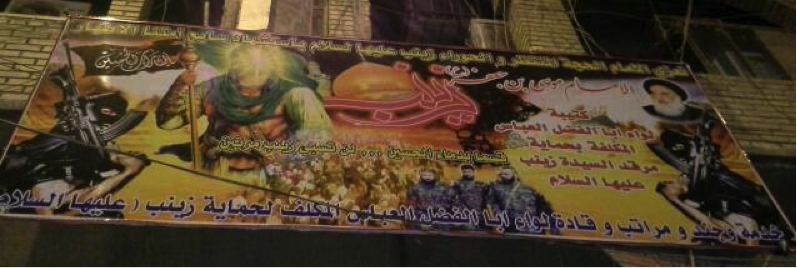
Figure 1: A banner featuring (shown wearing camouflage fatigues) Abu ‘Ajeeb (left), Abu Shahed (center), Abu Hajar (right) are pictured together as the leadership for LAFA. The photo of the banner was first posted on Facebook on June 6, 2013, 24 hours after the announcement of the creation of Liwa’a Zulfiqar.
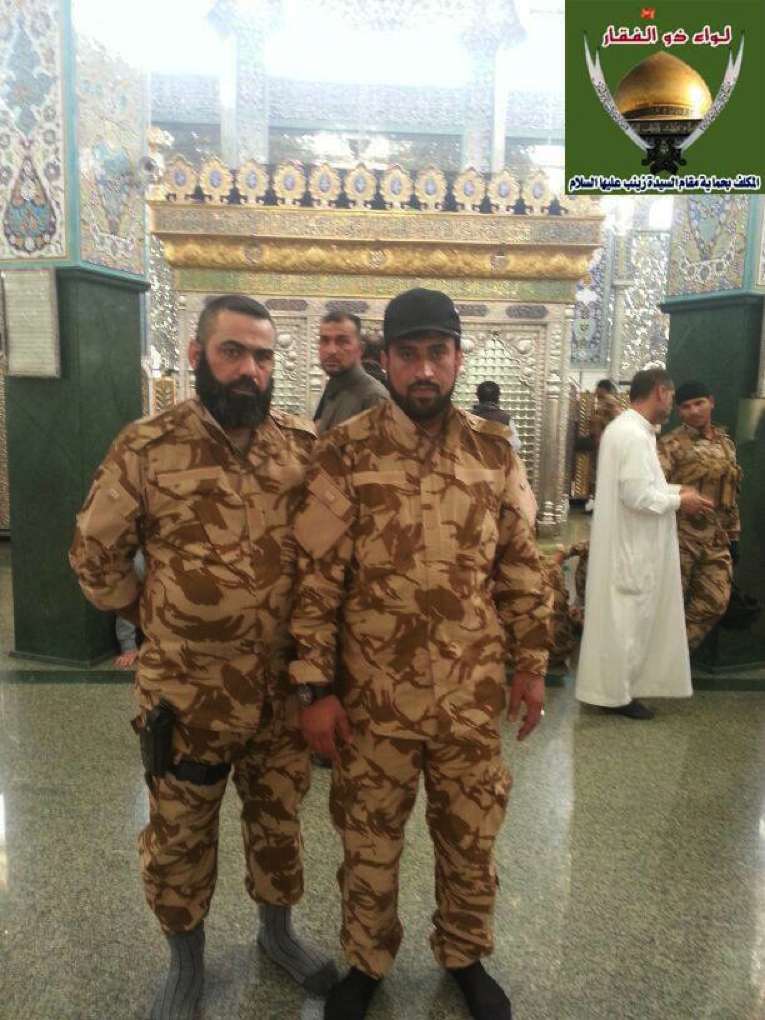
Figure 2: Abu Hajar and Abu Shahed stand together in the Saydah Zaynab Shrine.
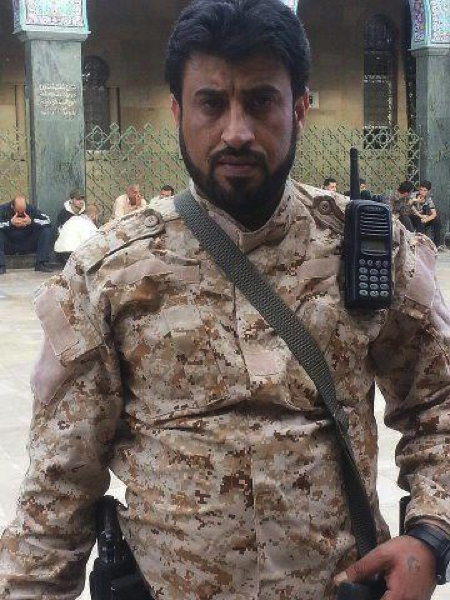
Figure 3: Abu Shahed, shown in an April, 2013 LAFA photograph. In the picture he is wearing a desert pattern MARPAT style uniform. The photo has been reposted on LZ’s Facebook.
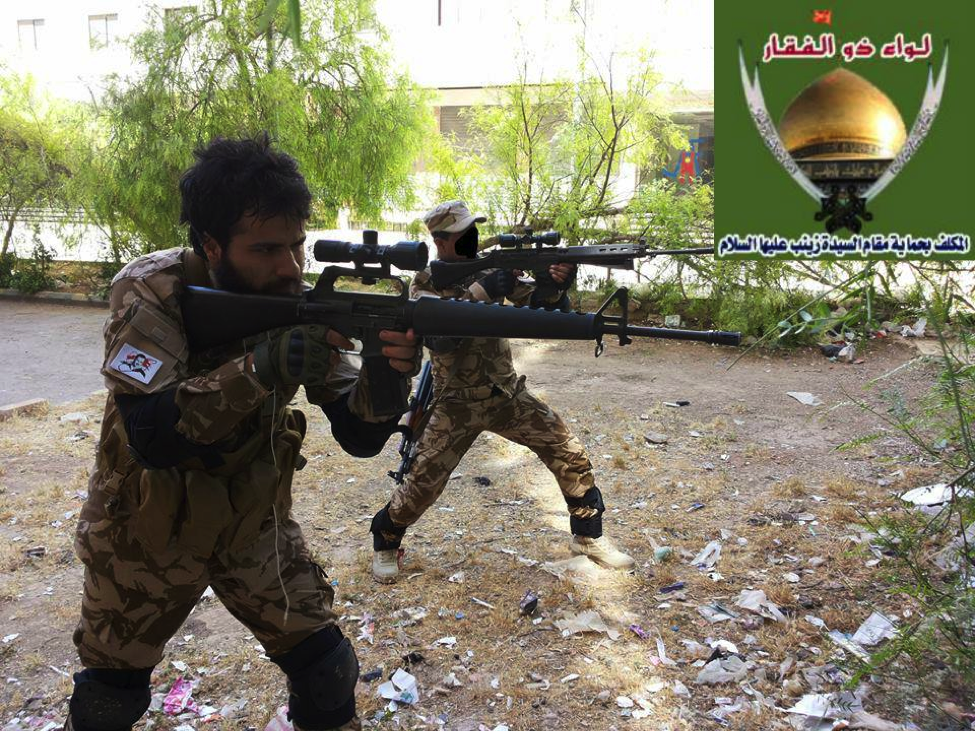
Figure 4: Abu Jafar al-Assad takes aim with an M16A1 style rifle. Another LZ/LAFA militiaman also takes aim with an FN FAL. A Bashar al-Assad patch is fastened to Abu Jafar’s arm.
Symbolism
The creation of Liwa’a Zulfiqar and their symbol also coincided with the creation of a new symbol for Liwa’a Abu Fadl al-Abbas. LAFA’s new logo was first adopted on the group‘s official Facebook page on May 31, 2013. Both logos include stylized images of crossed Zulfiqar-style swords. The dome of the Saydah Zaynab Shrine also features prominently.
It is important to note that both logos are quite similar in design. It can be assumed that this was not likely due to unoriginality, but instead was done to demonstrate common themes. The adoption of these new symbols is a clear example of the both organizations attempting to capitalize on the fate of the Saydah Zaynab Shrine and on placing clearly Shia symbols as centerpieces of their respective organizations.
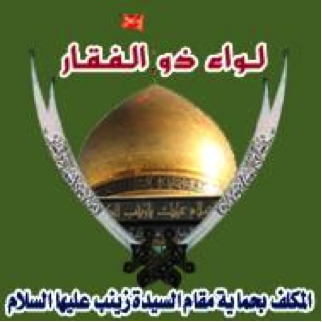
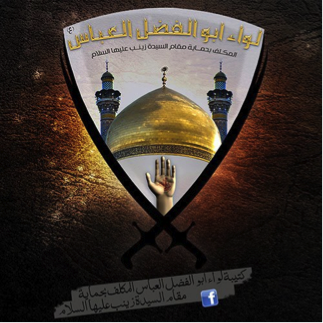
Figure 5: Liwa’a Zulfiqar’s logo (Left).
Figure 6: Liwa’a Abu Fadl al-Abbas’s new logo (Right).
What’s In A Name?
As with Liwa’a Abu Fadl al-Abbas, Liwa’a Zulfiqar’s name has deep roots within Shia Islam. According to Shia tradition, the Zulfiqar was a sword which originally belonged to the Islamic prophet Muhammad. According to Shia tradition, the legendary double tipped sword had immense strength and was passed on to Imam ‘Ali by Muhammed as he lay dying. For Shia, the handover of the sword connoted the passing of the mantle of Islam’s leadership to ‘Ali. The sword also formed a central facet for ‘Ali’s renowned status as a warrior.[3]
A popular traditional Shia saying, which invokes Imam Ali and the Zulfiqar says, “La fata illa ‘Ali, la saif illa zulfiqar” (“No victor like Ali, no sword except the Zulfiqar”).[4] Jennifer G. Wollock also notes the Zulfiqar’s near mystical qualities saying, “[Zulfiqar is] famous in its own right…[J]ust as King Arthur’s sword Excalibur or Roland’s Durandal…[I]n the West.”[5]
For Shia Muslims, the Zulfiqar and its significance did not simply disappear with the assassination of ‘Ali. It is believed the sword is the weapon to be wielded by the Mahdi, Shi’ism’s messianic figure who will usher in a time of justice and end oppression.[6] For Shia, particularly Twelver Shia, the Mahdi is the true ruler of earth—the final Imam—hidden by Allah and set to return. Contemporarily, the messianic theme of connecting the Zulfiqar to the Mahdi is also still popular with many Shia.[7]
Accordingly, the Zulfiqar’s powerful symbolism is being wielded by LZ to demonstrate power, commitment to the protection of Shi’ism, traditional Shia themes, messianic motifs, and as a military symbol.
The Fighters of Liwa’a Zulfiqar
Interestingly, LZ’s photographic posts for their fighters seem to include shots of them dressed in desert-pattern camouflage. LAFA members photos are more generally seen in woodland and urban themed MARPAT-style camouflage clothing. The emphasis on the desert pattern uniforms may be LZ’s attempt to posit a clear and visible difference from LAFA.
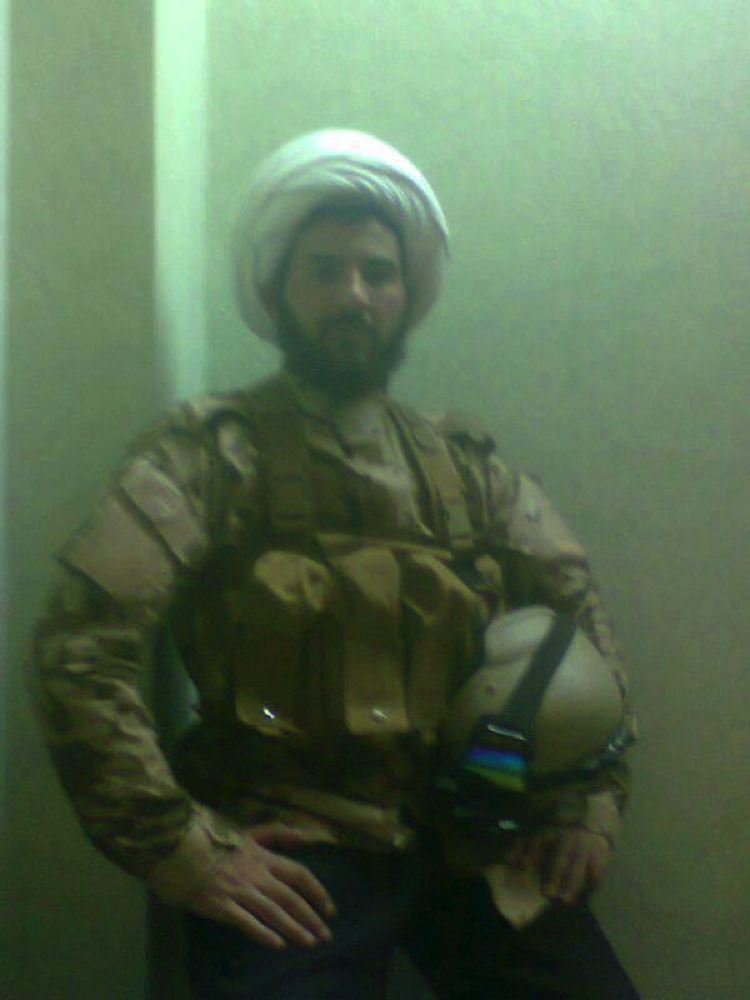
Figure 7: The fighter’s white turban and beard indicate he may hold the status
New audio-visual message from the Islamic State of Iraq and al-Shām’s Shaykh Abū Muḥammad al 'Adnānī: "So Fight Them, Verily They Are Polytheists"

__________
To inquire about a translation for this audio-visual message for a fee email: [email protected]
New audio-visual message from the Islamic State of Iraq and al-Shām's Abū Bakr al-Ḥussaynī al-Baghdādī: "Remaining in Iraq and al-Shām"

____________
To inquire about a translation for this audio-visual message for a fee email: [email protected]
al-I’tiṣām Media presents a new video message from the Islamic State of Iraq: "It Does Not Harm Them Whoever Betrays Them"
al-Anṣār Media Foundation presents a new video message from Anṣār al-Islām: "The Supporters: The Global Perspective and Path"
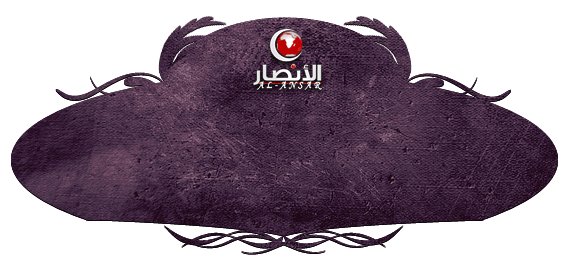
___________
To inquire about a translation for this video message for a fee email: [email protected]
New statement from Anṣār al-Islām: "To the Sunnī People in Iraq"

Click the following link for a safe PDF copy: Anṣār al-Islām — “To the Sunnī People in Iraq”
__________
To inquire about a translation for this statement for a fee email: [email protected]
Hizballah Cavalcade: Kata’ib Sayyid al-Shuhada: Another Supplier of Iraqi Shia Fighters in Syria
NOTE: For prior parts in the Hizballah Cavalcade series you can view an archive of it all here.
—
Kata’ib Sayyid al-Shuhada: Another Supplier of Iraqi Shia Fighters in Syria
By Phillip Smyth
Click here for a PDF version of this post
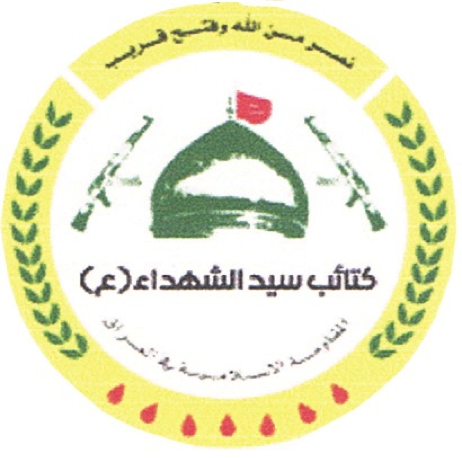
Figure 1: Kata’ib Sayyid al-Shuhada’s symbol.
Following funerals for some of its members killed fighting in Syria, The Kata’ib Sayyid al-Shuhada (The Battalion of the Sayyid’s Martyrs or KSS) has quietly established itself as an Iraqi Shia militia force contributing combatants to the battlefront in southern Damascus. At present, the KSS’s main raison d’être appears to be as a source for Iraqi Shia fighters who can be used to “Defend the Zaynab Shrine”, a major Shia Islamic site in Syria.
The first reports of KSS’s existence occurred on April 14, 2013. In one press report, it was stated that KSS initially went by the names of Kata’ib Karbala (the Karbala Battalions) and later as Kata’ib Abu Fadl al-Abbas.[1] Interestingly, a group which had targeted American and Coalition forces in Iraq was and Iranian-backed “Special group” called Kata’ib Abu Fadl al-Abbas.[2] Adding further significance to the KSS’s earlier names and its links to Syria; KSS sends its fighters to Syria where they act as an intrinsic part of the Syrian-based Liwa’a Abu Fadl al-Abbas (LAFA).
It was reported that the KSS was formed due to splits within the Iranian-created and backed Kata’ib Hizballah.[3] These contentions were initially based on nameless sources and were reported by a small number of Iraqi Arabic-language publications. It was also claimed that Abu Mustafa Sheibani (Hamid al-Sheibani), a pro-Iranian militia leader, who had been involved with the creation of many so-called “Special Groups” (including Asa’ib Ahl al-Haq and Kata’ib Hizballah) was KSS’s leader.[4] According to a Washington Institute for Near East Policy report, Sheibani “holds both Iranian and Iraqi citizenship” and when operating in Iraq, concentrated on the, “distribution of explosively formed penetrator (EFP) roadside bombs”.[5]
Based on the KSS’s few public appearances and its activity in Syria, it is likely the organization has a steady source of funding. Said funding allows the group to hold attention grabbing funerals and to put on airs of professionalism and organization. Nevertheless, based on Iraqi media, forums, and other social media sources, the size of the group’s membership, leadership, recruitment activities, and amounts of money it may receive remain unknown or unconfirmed.
Mirroring the activities of other Lebanese and Iraqi pro-Iranian groups, such as Kata’ib Hizballah, Asa’ib Ahl al-Haq, and Hizballah, the KSS sent a number of fighters to serve in the ranks of the Damascus-based Liwa’a Abu Fadl al-Abbas. When these fighters were killed, LAFA was often the initial or only group which would claim them as members. Only when Iraqi family members of dead fighters were interviewed, was it revealed their deceased relatives were also members of KSS.[6]
Pointing to direct Iranian support for KSS, the bodies of fighters who belonged to the organization have, on all occasions involving a funeral, been returned to Iraq via Iran. On May 6, 2013, the funeral for Diya Issawi included claims he belonged to KSS and that his body was returned to Iraq from Iran, through Basra.[7] Later that month, on May 17, 2013, two more funerals were held for Iraqis killed in Syria. The first, for Hassan Ali Farhud, was held in Sadr City, a Shia section of Baghdad.[8] The second funeral, for Muhammed Aboud al-Maliki, was held in Basra. Paralleling the return of Issawi’s body, Farhud and Maliki’s bodies were delivered through Iran. (Note: Partial profiles for Farhud, Issawi, and Maliki, were provided on Hizballah Cavalcade’s “Roundup of Iraqis Killed in Syria, Part 2”).
During funerals for its members, the KSS has fielded guards dressed in matching camouflage fatigues and a full color guard holding a mixture of KSS and Iraqi flags. Coffins for the dead are usually covered with Iraqi national (often painted onto the casket) and KSS flags. In most cases, the funeral processions resemble other funerals held for members belonging to Kata’ib Hizballah and Asa’ib Ahl al-Haq.

Figure 2: KSS statement released on May 8, 2013.
Following the funeral for Issawi, KSS declared its goals in a press statement issued by its media office. The group stated its aims included the protection of “shrines across the globe”, the preservation of “Iraqi unity”, and an end to sectarian conflict. It was claimed by KSS that its enemies were “Sowing [Islamic sectarian] discord” due to their “suspicious motives”. The group also mentioned that Israel is “Cancerous”, the U.S. occupation of Iraq was a symbol of “Arrogance”, and called for Jerusalem to be liberated.[9] For all intents and purposes, KSS repeated many of the main talking points presented by Lebanese Hizballah and Iran, albeit with an Iraqi spin.[10]
Despite the group’s statement claiming it was against sectarianism, some Iraqi forums reported the group had threatened to kidnap Iraqi Sunni Muslims.[11] Nevertheless, the KSS’s military activities appear to be limited to engagements in Syria.
WARNING: GRAPHIC IMAGES
Videos featuring KSS members have also been a relative rarity. Save for the posting of funeral videos made for fallen KSS members, only one video—posted on May 28, 2013—claims to be a KSS-specific combat video. Released on YouTube, the film purports to show KSS members (likely attached to LAFA) operating in Syria and displaying the dead bodies of what the video refers to as, “Wahhabi Free Syrian Army mercenaries”. Further linking KSS to LAFA, the film was set to an Iraqi-made pro-Liwa’a Abu Fadl al-Abbas song, which first appeared online in early-2013. KSS members present in the film can also be seen wearing fatigues which are commonly worn by LAFA members.
When compared to LAFA and Lebanese Hizballah, social media and forum presence for Kata’ib Sayyid al-Shuhada has been sparse. What appeared to be a main Facebook “page” was created for the group on April 19, 2013.[12] However, the page conveyed little information and most posted material came on the day it was created or on April 26, 2013. The majority of the postings were of edited photos (mainly of the Zaynab Shrine) which could also be found on most pro-LAFA and pro-Hizballah websites. It is unknown whether the page was sanctioned by the group’s leadership. Membership for the page stands at fewer than 200. Additionally, a preponderance of those who “liked” the page lived in Baghdad, Iraq.
Facebook “Groups” have also been created for Kata’ib Sayyid al-Shuhada. Most of these groups have less than 300 members and tend to contain more information about the organization. Photos made specifically for KSS are present on these devoted KSS group pages. However, they tend to utilize imagery which has been used previously by LAFA. In general, KSS’s images are at times more amateurish than with other Shia militias operating in Syria.
The KSS’s dead maintain positions of prominence in KSS Facebook groups. On rare occasions, photos of live KSS members serving with LAFA have their faces blurred. One KSS group page even featured photos of what were presumably KSS fighters arriving by bus to the frontlines in Syria. Based on the captions provided for these and other photographs, it appears that KSS fighters may primarily originate from Basra, Iraq. Incidentally, the many mentions of Basra would also coincide with two of the three funerals for killed KSS members, since they also occurred in Basra.
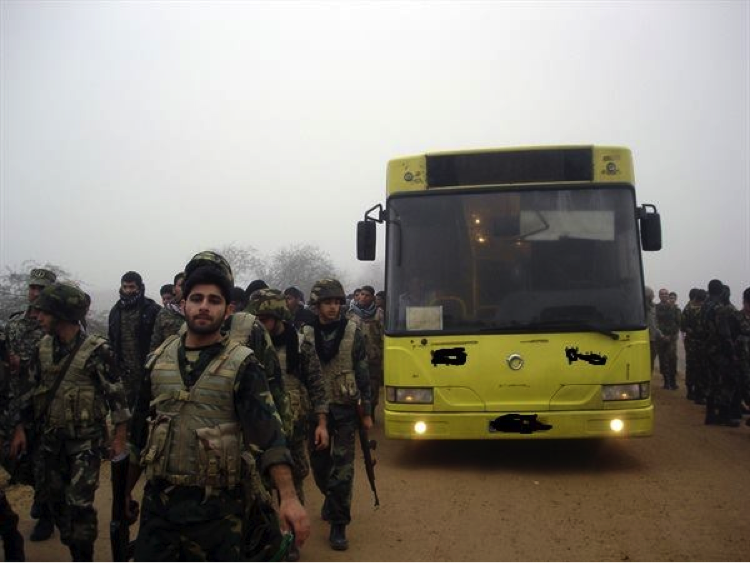
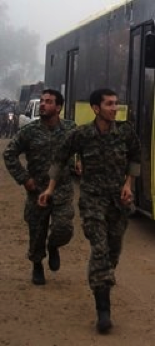
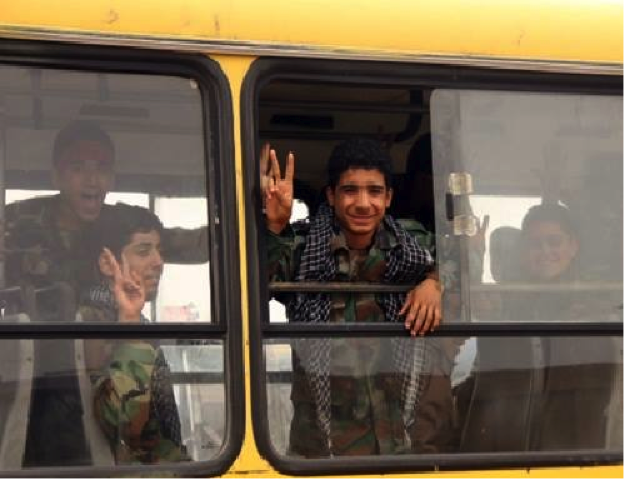
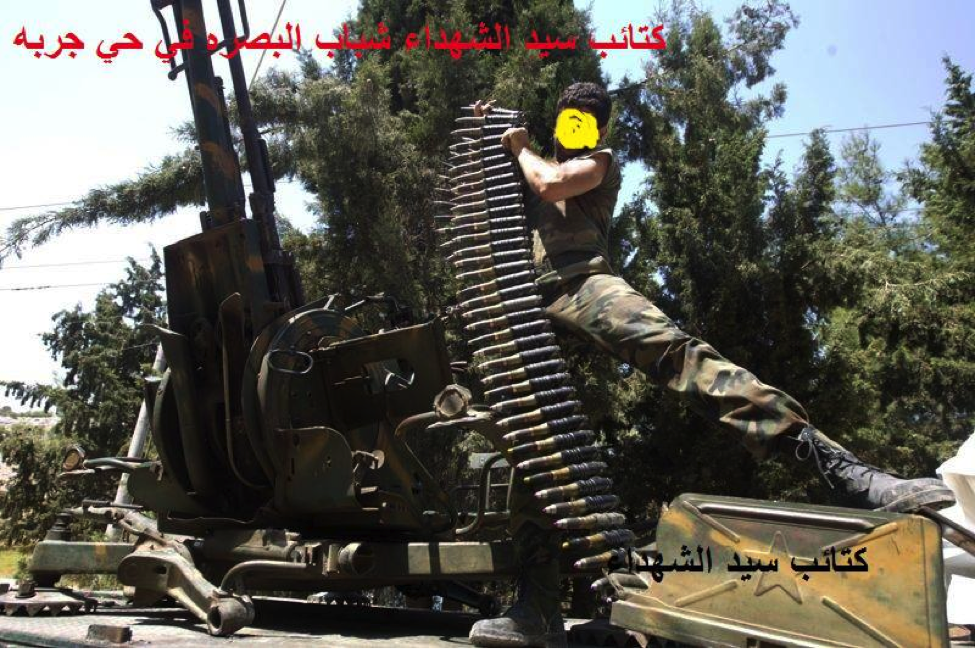
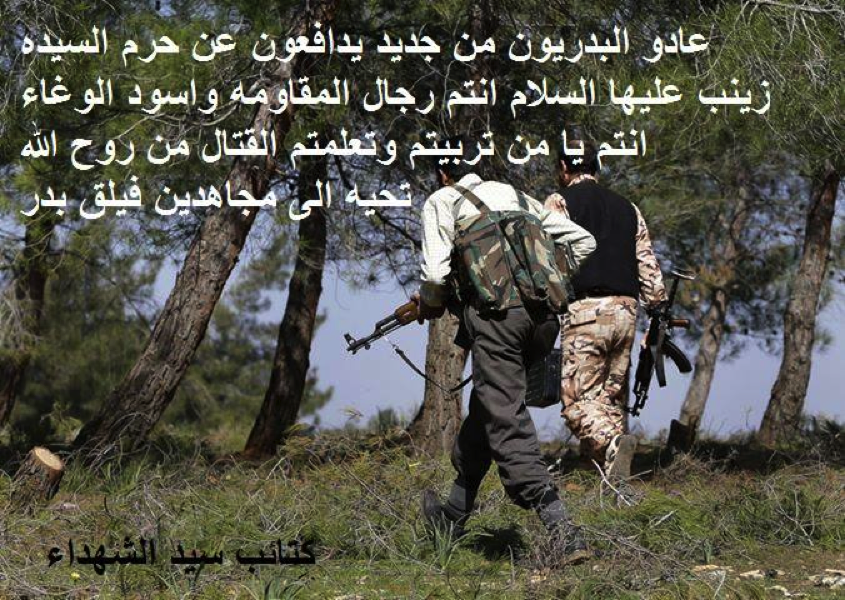
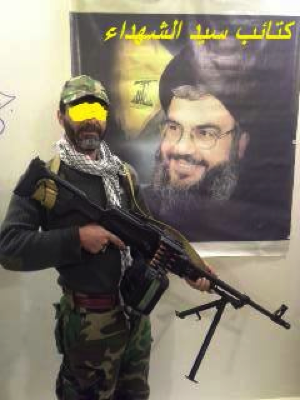
Figure 3: A KSS member is seen posing with a poster for Lebanese Hizballah leader Sayyid Hassan Nasrallah.
Underpinning the KSS’s Zaynab Shrine-centric role, their official symbol has a number of key images which emphasize Shi’ism, the Zaynab Shrine, and militarism. First, a stylized and green-colored image of Damascus’s Zaynab Shrine’s dome stands in the center with a red banner flying from the top. The raising of the red banner—symbolizing martyrdom and sacrifice—on top of the Zaynab Shrine has been used to great propagandistic effect by Shia groups such as Lebanese Hizballah and LAFA. The dome is flanked on two sides with images of AK-47 rifles. Around the dome on a roundel is a laurel wreath. At the bottom of the roundel are stylized blood drops. The blood drops may serve as a

